The post Psy Fans Gallop To Gangnam District (And Why I’m Not Happy About It) appeared first on The Expeditioner Travel Site.
]]>
You might assume that most global citizens have had enough of Psy, the infamous rapper who, if he didn’t invent his signature “gallop” dance, certainly resurrected it. You may think this genius of a man has been transformed into something even more obsolete than a teeny-bopper’s “so over” description: gasp, a meme.
Though Psy has garnered a record-breaking billion-plus YouTube views for his hit “Gangnam Style,” in a world of rapid turnover, this international superstar is a little dated, at least in the United States. However, in his home country of South Korea, Psy’s influence still reigns — even if his signature song isn’t constantly blared in every club, as was mandatory in Stateside bars when the song first caught on.
Love him or hate him, Psy has sparked worldwide interest in South Korea. What previously resided in American minds as North Korea’s progressive older sibling, South Korea is increasingly regarded as a bona fide hotspot for experiencing K-pop culture and luxury beyond what Las Vegas has to offer, particularly in Seoul’s storied Gangnam neighborhood.
“In Gangnam’s Apgujeong neighbourhood, K-pop stars are delivered to their entertainment companies’ headquarters in gleaming black Hyundai Starex people-movers with tinted windows,” notes the Sydney Morning Herald, “while Seoul’s super-rich worship at the flashy temples of luxury fashion lining a boulevard of dreams dubbed ‘yuppie street.’”
Endless mounds of fun seem to be had in Seoul. In the SMH article, the Gangnam District is described as home to trendy clubs to which only sub-30, super-rich glamazons may enter, karaoke-fueled bars and non-negotiable shots of soju paired with silkworm larvae snacks. Frankly, a Friday night in Seoul’s Gangnam District seems like a night I would like to experience at least once in my life. Of course I would be armed with a fistful of cash, an outfit akin to a disco ball and a well-rehearsed K-pop song primed for karaoke. When in Rome, right?
But there’s something about Seoul’s newfound attraction that’s unsettling. It leaves a bad taste in my mouth — what I imagine to be the flavor of silkworm larvae.
Are we so blind to the interesting, unique parts of the world that a stupid (there, I said it) pop song is the catalyst that places it on our radar? I confess, I didn’t give Seoul — let alone Gangnam — much thought prior to viewing Psy’s video an embarrassing number of times.
I suppose this phenomenon is nothing new. After Editor-in-Chief Matt Stabile’s favorite book by Elizabeth Gilbert, Eat, Pray, Love, was published, Bali experienced a surge in tourism by “mostly 40-something female travelers who’ve arrived looking for their own spiritual enlightenment and time to put in on their own soon-to-be bestsellers,” as an earlier article on The Expeditioner reports. Likewise, Seoul had 11.1 million visitors in 2012, “a figure that was up 13.4 percent on 2011,” according to the country’s Culture Minister.
Maybe Seoul is the new Mecca for techno-loving, wealthy club kids. Let’s not forget that people have been traveling to far flung places they’ve never heard of on the basis of an idea and a somewhat-trusted tip. For example, The Lord of the Rings movie trilogy spurred a massive increase in travel to New Zealand. The Oregon Trail, the California Gold Rush, Columbus’s New World — this is not a new story.
So perhaps it’s unwarranted to be frustrated by this wave of Gangnam tourism. I implore you, book a flight if you wish. But for the sake of your own pride, at the very least, tell family and friends you’re going there for the culture — not to learn the gallop dance.

About the Author
 Jenna Blumenfeld, (Jenna Ogden Blumenfeld when she’s in really big trouble) hails from the wee state of Connecticut. Although her childhood dream of becoming a bug doctor — with a specialization in ladybugs — has gone unfulfilled, she is content writing about travel, cuisine and culture. A vegetarian, she currently resides in the food hub of Boulder, Colorado. Read more of her food-centric writing at NewHope360.com.
Jenna Blumenfeld, (Jenna Ogden Blumenfeld when she’s in really big trouble) hails from the wee state of Connecticut. Although her childhood dream of becoming a bug doctor — with a specialization in ladybugs — has gone unfulfilled, she is content writing about travel, cuisine and culture. A vegetarian, she currently resides in the food hub of Boulder, Colorado. Read more of her food-centric writing at NewHope360.com.
The post Psy Fans Gallop To Gangnam District (And Why I’m Not Happy About It) appeared first on The Expeditioner Travel Site.
]]>The post Mixing It Up In Seoul: 5 Unique Ways To Experience South Korea appeared first on The Expeditioner Travel Site.
]]>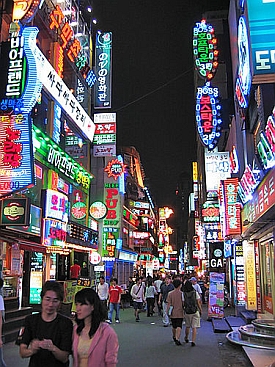
Travelers often feel a certain pressure to see everything of historical and cultural significance when they visit a new city or country. They frantically rush from museum, to monument, to palace as if they are writing a guidebook, and before they know it, the trip is over. They return home exhausted, armed with an overabundance of stock postcard pictures hastily snapped in front of [insert appropriate tourist attraction here] to show to their family and friends. Not only does this method of travel limit their understanding of the contemporary culture, but what’s even worse, it doesn’t seem to be much fun.
I spent the last six months living and teaching in Seoul, South Korea. During this time it was not the guided tours or visits to significant sites that ultimately shaped my understanding of the country, but rather the common everyday happenings that were both revelatory and enjoyable. My best moments came when I stopped viewing Korean culture from afar and instead participated in it.
With this in mind I have created a list of things to do in Seoul. While the obvious attractions — Namsung Tower, the DMZ, the palaces, Myeong Dong, Insadong — are all places I recommend you visit if you have time, my list is intended for people in pursuit of a more unique and participatory experience. It includes some things your average Korean might do in a weekend and other things that are a bit more creative. But for me, all of them share two characteristics: they are uniquely Korean, and they are potentially a lot of fun.
 1) Go to a Sporting Event
1) Go to a Sporting Event
During my time in Korea I went to two sporting events, a Korean Basketball League (KBL) game, and a professional Korean baseball game. Although the level of play varies between the sports the excitement and energy of the crowd does not. Since Koreans love baseball, this tends to manifest on the field with high-caliber players and teams. A more indifferent attitude towards basketball also shows. But don’t let the fact that Duke might beat a KBL team by 40 get you down. What’s fun about these events is the atmosphere.
The prices are affordable ($6-$14), and Koreans haven’t yet realized that once you get fans inside a stadium you can shut the doors and pinch ‘em for every penny. As a result, it’s perfectly normal to bring your own food and drink to the game. In fact, if you don’t they might think you’re a foreigner! It’s a picnic, so pack your favorite snacks or buy something from the street vendors outside Jamsil Stadium and enjoy. And if you so happen to run out during the course of the game, you can leave the stadium and return with another armful of whatever your stomach desires.
Koreans are also very participatory at sporting events. Each team brings their own MC and dancing girls to pump up the crowd, and the crowd chants motivational songs throughout the game. A lot of these songs have taken the liberty to borrow (or steal) the rhythms from popular American sports songs. So when you think you are hearing “Take me out to the ball game,” except it’s in Korean, there’s a good chance you are.
Note: They don’t have hot dogs at Jamsil baseball stadium but they do have fried octopus. It’s salty, chewy, and delicious. Give it a try!
2) Jimjilbong
The jimjil (heated bath) bong (room) is Korea’s version of the spa. It includes Jacuzzis, cold water baths, showers, massage tables, steam and ice rooms, and usually a common room for watching TV, drinking ginseng shakes or iced sikhye and eating cold noodles. And unlike many western spas, it is very affordable (usually around $6-$10).
If you’re shy about walking around in your birthday suit as curious Koreans take platonic sneak peeks, don’t worry. Head to the common room where both sexes mingle fully clothed and enjoy the steam rooms and relaxed atmosphere. This is about as laid-back as Korea gets, and if you leave without spotting at least one old man comfortably asleep on the wooden floor, write me a letter of complaint.
Note: At night Jimjilbong’s transform into a sort of hostel. Mats are provided and men and women stretch out along the floor as though it’s made of feathers. It only costs about $6 and is a common thing for Koreans to do, especially those living outside of the city. While in the States this sort of thing might become dangerous, in Korea it’s as calm and peaceful as a night under the stars. If you’re strapped for cash and need a place to crash, avoid seedy Love Motels and try a night alongside the community.
 3) Nori Bong
3) Nori Bong
This Korean take on karaoke is a must-do. Nori (sing) Bong (room) is as ingrained in the Korean lifestyle as studying and working hard. A Nori Bong generally consists of many small private rooms, each containing a full karaoke setup and a book filled with popular Korean and Western songs. Don’t worry, half of the book is in English and you’ll find the song that makes you sing like a hummingbird.
You can usually purchase beer or soju there and if not, they’ll let you bring it in, all in the spirit of enhancing your voice or disillusioning the ears of your company. If you walk in and hear a woman belting “I’m so lonely” by Akon in less-than-perfect English, you’re in the right place.
Note: Nori Bongs are as common as plastic surgery in Seoul, and if you have any trouble finding one you must not be in Korea.
4) Soju Tents
To escape from Korea without at least one shot of soju, even for the most sober of travelers, isn’t easy. At times it seems that in every bar, bowling alley, club, kimbap, seafood, or galbi restaurant, there is a group of well-dressed men drinking soju and smoking cigarettes. But whether you fancy wetting your lips or not it is worth your time to dine in one of the many brightly-colored (usually orange) tents that appear all over Seoul and that foreigners tend to call “soju tents.”
“Soju tents” are usually run by an old Ajumma and someone in the family, and are cheap and full of delicious Korean food. Try pachun, a Korean omelet style dish that can be had with an array of vegetables or seafood. Also, drinks are cheap here and the environment authentically Korean. Some tent owners will give you special attention and care because you are foreign, and others may be rude or shy for the same reason. Either way, you will get a sense of what it’s like for foreigners living in Seoul.
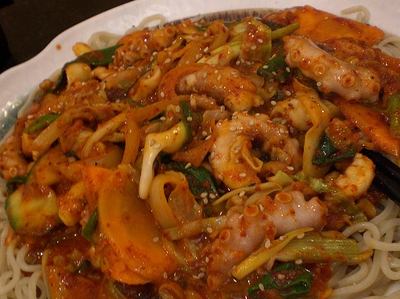 5) Eat Nakji
5) Eat Nakji
Eating nakji is not for the weak-of-stomach or overly sensitive, and during my first three months in Korea I didn’t even consider it. Nakji is a type of small octopus that are kept in large tanks outside of many Korean restaurants and street tents. When served the nakji is removed from the water and quickly chopped up, usually by an Ajumma (older married woman) with a very large knife. But what makes the nakji so appealing (or appalling) is that when it is brought out on a plate, soaked in sesame oil and sprinkled with sesame seed, the tentacles are still moving. Some are doing a final slow dance and others appear as though they might break free and squirm violently across the table, pick up a chop stick and stab you in the neck in a mad fury of revenge.
So why do I recommend this? Well, after trying it not only did I realize the squirmy devils are surprisingly tasty once you adjust to your food moving around in your mouth, but because most importantly, it’s fun. Whether you go to a small street tent that specializes in seafood, or an actual nakji restaurant, there will undoubtedly be locals throwing back shots of suju, smoking cigarettes, laughing and eating all sorts of sea critters you’ve never seen before. If you get lucky you might even see someone eat a full octopus, Old Boy style.
Note: If you’re traveling alone and aren’t willing to try a full plate of nakji yourself, order something you’re more comfortable with: oysters, clams or fish. When you see a plate of wiggling nakji being brought to a table of inebriated Samsung executives, express your curiosity. Hard-drinking Koreans are famously (or notoriously) friendly to foreigners after a hard day’s work, and you might find yourself with a complimentary soju shot in hand and a slimy octopus tentacle coming right at you. Enjoy! And be sure to chew fast and hard!
*
No matter your length of stay in Seoul, if you make an effort to participate in the culture you will be rewarded. The more Koreans observe you putting forth the effort, the more receptive they will become towards you. Don’t be afraid to be uncomfortable. To surprise yourself in a challenging situation can be one of the most rewarding experiences traveling has to offer.
By Nathaniel Kostar
[Seoul Street Night Scene by temp13rec/Flickr; Cheering for your baseball team by SamsungTomorrow/Flickr; Travel in South Korea by ihaterainy/Flickr; Nakji Bokkeum by Suddenly Susan/Flickr]

About the Author
 Nathaniel Kostar is a freelance writer and student currently pursuing his MFA in creative writing with The University of New Orleans. He is working on his first non-fiction book, which details his journey as he attempts to learn poetry, art, fighting, music, dance and philosophy (all skills expected of Italian Renaissance men) in various countries around the world. More of his writing can be found on his blog at WeSproutWings.com.
Nathaniel Kostar is a freelance writer and student currently pursuing his MFA in creative writing with The University of New Orleans. He is working on his first non-fiction book, which details his journey as he attempts to learn poetry, art, fighting, music, dance and philosophy (all skills expected of Italian Renaissance men) in various countries around the world. More of his writing can be found on his blog at WeSproutWings.com.
The post Mixing It Up In Seoul: 5 Unique Ways To Experience South Korea appeared first on The Expeditioner Travel Site.
]]>The post This Is Why You Want To Experience Seoul’s Nightlife appeared first on The Expeditioner Travel Site.
]]>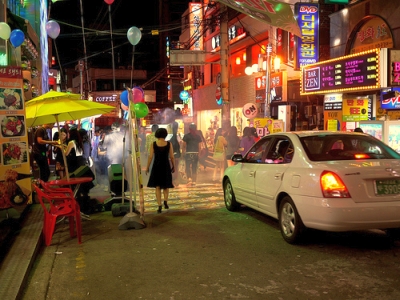
Quite simply, it rocks and will probably suck you in. On a recent trip to the Korean capital, my friends and I found it utterly impossible to break the cycle of pre-dinner drinks, delicious Korean food, bars and street food, followed by an early afternoon wake-up call. We had every intention of sightseeing-filled days, a trip to the North Korean border to see the DMZ, wandering the city palaces and more, but in the end we succumbed primarily to the night.
Luckily, we live close and were only traveling on a quick 90-minute flight over from Shanghai on a Chinese New Year getaway. Coincidentally, Korean New Year falls on the same day, meaning some sights were closed, and others, such as traditional palaces were bustling. With such cheap flights available anytime, the pangs of guilt for seeing the inside of more bars than museums were assuaged with the knowledge we could return again on a whim.
Seoul’s extensive airport bus system divides the city into quadrants, and then stops just about anywhere you may be staying, hostel or hotel, quickly and directly. Although Seoul is a vast metropolis, the city’s easy-to-navigate subway system — which is the third-largest in the world by passenger volume — can take you just about anywhere, and even far enough outside the city to see mountains and to camp.
Most visitors gravitate towards the district of Itaewon, located near a large U.S. military base, and known locally as something of a “ghetto” due to the large number of immigrants and foreigners. To say that Itaewon attracts a varied assortment of people would still be an understatement. In addition to the military personnel, young Koreans abound, and English teachers come from all corners of the city for a night out. “Homo Hill,” a collection of gay bars on a steep street is a central fixture. “Hooker Hill,” just two streets over, is a separate (but equal) sight unto itself, despite recent government attempts to crack down on the brothels. Pool bars, hookah lounges, catchy K-pop tunes, Döner Kebab and cheap, delicious Soju are all at your fingertips in Itaewon. A bit sweeter than vodka due to the sugar added in the distillation process, a bottle will only set you back $1-$3 from a convenience store, and just a bit more at restaurants.
Perhaps even more importantly is the abundance of street carts selling delicious grilled meats and snacks well into the night. Sweet grilled chicken skewers are a must, as are the delicious fried dumplings, known as mondu. The atmosphere remains vibrant and convivial, with the occasional skirmish to be seen between some military boys who let loose a little too hard on their day off. In the extremely safe city, Itaewon’s police branch must be the busiest. These fights are generally easy to see coming and avoid however, so it’s relatively easy to stay uninvolved.
Then there is Hongdae district, which is a whole different plate of kimchi. Certainly the best nightlife and people-watching district the city has to offer, the area offers a much more typically Korean atmosphere, although equally raucous. As opposed to the bars that dominate Itaewon’s scene, Hongdae, located near a major university, trends more towards clubbing, live music and karaoke in addition to the bars, restaurants, and street stalls.
Like most places in Asia, karaoke in Seoul means renting a room with friends to belt out some power ballads, not performing on a stage in front of strangers. While not always the best method for meeting new people, it’s a fun way to get warmed up for the rest of the night to come. Food options abound, so come early, hungry, and be prepared to stay until the subways open around 6 a.m. If you have an aversion to Red-Bull and get caught in the no-zone of 12 a.m. to 6 a.m., taxis in Seoul are surprisingly cheap. Even a 30-minute late-night ride to the other side of town will only set you back around $20.
To rejuvenate, sometimes you just need a vacation where eating and drinking counts as sightseeing. If you’d like to make it sound even more cultural due to lingering catholic guilt, call it building understanding through analyzing the local country’s culinary tradition. If that’s a concept you’re comfortable with, Seoul cannot possibly disappoint.
By Kyle Long of UnTourShanghai.com
About the Author
Kyle Long is the Chief Running Officer of UnTourShanghai.com, an urban adventure tourism company specializing in jogging sightseeing excursions and custom culinary and food experiences in Shanghai, China.
[Nightlife by Martin Bengtsson/Flickr]
The post This Is Why You Want To Experience Seoul’s Nightlife appeared first on The Expeditioner Travel Site.
]]>The post A Welcome Of The Most Korean Kind appeared first on The Expeditioner Travel Site.
]]>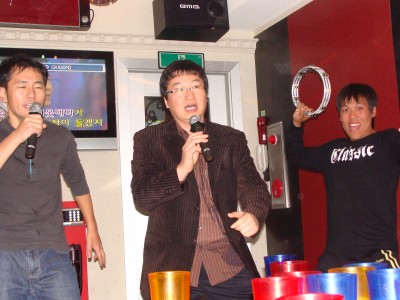
South Korea, my Asian home away from home where I experienced my first living abroad experiment, is an anomaly of sorts, really. There are aspects of the culture I will never comprehend, nor should I. There are things in which I tilt my head in confusion, which is fine. There are things I embrace and wish the world would adopt, which it should.
Perhaps encapsulating all three of these at once, I read a recent article at The New Zealand Herald that sent me spiraling back to my first days in the “Land of the Morning Calm.” The article is titled, “A warm welcome without words,” and it couldn’t be more accurate.
Those that have spent any time in Korea know that it takes a little while for the locals to achieve a comfort and confidence level to put themselves out on a limb using their English. Let’s be perfectly honest about a couple things. One: Because of my one year of teaching elementary English in the rice farming community of Yeoju, the entire population of town is totally and completely fluent. I can’t speak for the rest of the country, though. Two: The Korean language is not quite yet a global dialect.
So, when the author’s first meal on a long layover in Seoul — a pantomimed conversation that ended up with a small keg of beer and some fried chicken parts (they tried to order small beers and French fries) — isn’t that unusual, what was unusual, especially for such a large city, was the pride and excitement that was evident by their arrival.
In this part of the city clearly we have novelty value. She finds us a table on the terrace and she smiles encouragingly. There is an almost complete language barrier . . . two of our fellow drinkers walk up and stop to welcome us to Korea and congratulate us on our choice of meal.
Where else do you know, in a city of over twelve million, are you “novelty” enough to be approached by two patrons simply to welcome you, let alone congratulate you, on your choice of food?
That brings me back to those memories of the first night in Korea. My teaching staff took me out for BBQ, too much soju (Korean rice liquor similar to vodka), and even more karaoke. I’m sure there were less than a dozen English words spoken the entire night. The crowd erupted into applause at my chopsticking abilities. I was pantomimed directions on proper eating and drinking etiquette, and even instructed on how to No Rae Bang (singing room). By the end of the night, there were hugs all around, and more laughing than I remember ever having in one night. I knew, instantly, this was a place I would enjoy.
And everyone knew the words to the song Kung-Fu Fighting. That sealed the deal.
The post A Welcome Of The Most Korean Kind appeared first on The Expeditioner Travel Site.
]]>The post Seoul: The Old, The New, The Perfect appeared first on The Expeditioner Travel Site.
]]>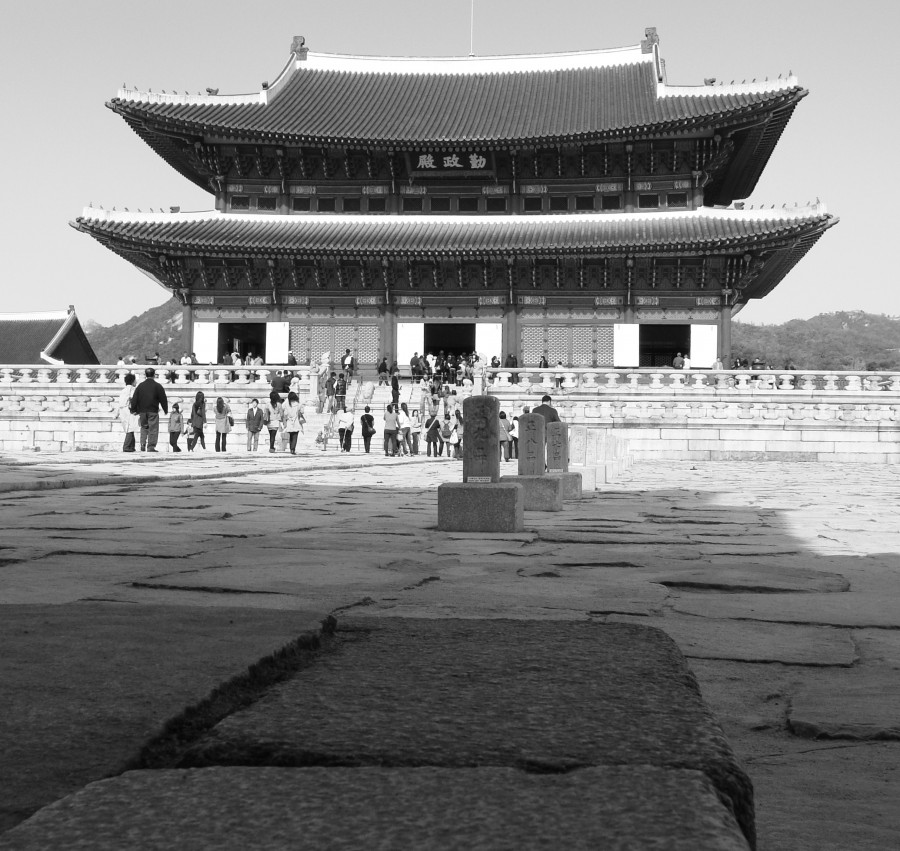
Korea, like an onion (or Shrek), is steeped in layers. Ancient history and tradition hold fast as trendy and progressive thinking prevail. It has an interesting dynamic of old and ultra-modern, most likely due to an age-old history of invasion. The fiercely held traditions are entwined within a country that is, literally, freshly built. Nowhere is the gap more dramatic than in the country’s capitol of Seoul.
Perhaps that is part of its charm. During my time in Korea, I would visit the electric streets almost weekly to take in the dense history in the morning, the teeming markets by afternoon, and the hip clubs by night. Seoul was my refuge, it was my insight, and it was my wonder.
Hemishpere echoes this with a “perfect” three-day itinerary for Seoul, introducing the city as, “a major metropolis with pockets that feel untouched by industrialization. The joy of a visit is in plunging into both sides of Seoul—the old and the new — and imagining where the city will go from here.”
Many of the sights suggest get the personal Jon Wick seal of approval (as if that matters, really, but at least I can vouch for them). For modern, head to Yonsan Electronics Market, where I picked up an Ipod for a killer deal, then to Dongdaemun to experience the youth phenomenon sweeping the globe. After catching up on the latest Girls Generation hits (Check out Gee Gee— you’ll be singing it all day), take a ride up the N Seoul Tower over looking the labyrinth that makes up the city.
For old Korea, and one of my personal favorites, head straight to the Insadong neighborhood, a hub of old world in the throngs of the new. Start exploring at Changdeokgung Palace, built in 1405, then to the Insadong shopping street for some traditional crafts (if you’re lucky you’ll get a to catch a traditional style impromptu street dance), then hit up the changing of the guards at Gyeongbokgung Palace — all within walking distance.
* Photo courtesy of TheExpeditioner Flickr Group and jonwick04.
The post Seoul: The Old, The New, The Perfect appeared first on The Expeditioner Travel Site.
]]>The post Almost Making It To The Top Of South Korea’s Jirisan appeared first on The Expeditioner Travel Site.
]]>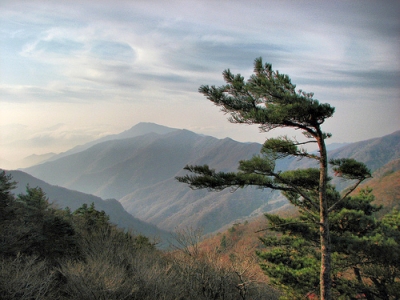
Jirisan, one of South Korea’s highest mountains, is a favorite hike in the country. But come prepared, it’s not as easy as you’d hoped.
By Andrew Post
Jirisan, the highest mountain in continental South Korea, is a 6,284-foot-high pile of rocks, trees, rivers, bushes, flowers, black bears, Buddhists and backpackers, located on the western fringe of Gyeongsangnam-do Province, in the national park of the same name.
Though not the intimidatingly tall Hindu Kush mountain range, Jirisan and its neighbors are still a tall order. These mountains comprise the southern tip of the Sobaek Range, running the length of both Koreas. They isolated the southwestern Korean provinces for millennia. The range is deceptively rugged. In winter, harsh winds scour the rock-strewn ridgelines. In summer, temperatures can shoot into the 90-degree-Fahrenheit range, with humidity to match. Some slopes are nearly vertical. Potable springs are miles apart. Coming to this wilderness unprepared is a recipe for disaster. Arriving over-prepared and late is even sillier.
Jirisan was only a two-hour bus ride from my home base on Geoje Island, south of Busan. So, one May evening, my friend Jeff and I — both ex-pat English teachers — scored some bad pizza, installed ourselves in my festering apartment, fetched up a map of the park, and began to plot a hike.
Because we’d be burning up two hours just to get to the mountain, we elected to make things quick and dirty. We chose the steepest and shortest route up: starting in the foothills at the village of Jungsan-ri, and ascending the eastern face to the highest summit, Cheonwangbong. Horizontally speaking, it was three and a half miles — an estimated three-to-five-hour trek, according to a Korean mountaineering blog.
It sounded simple, but we were determined not to neglect the slightest detail. Camping, we’d read, was illegal except in designated areas, but we packed a tent and sleeping bags anyway. We were macho like that. And the food we brought would’ve put the Berlin Airlift to shame: massive peanut butter and jelly sandwiches, trail mix (which we couldn’t stop calling by its alternative name: “gorp”), granola bars, fresh fruit, and copious amounts of water. In all, our packs weighed about 30 pounds each.
Everything went wrong after that.
We made the bus station the next morning only to discover that the 6 a.m. bus actually departed at 5:55 a.m. The next one wasn’t until 6:55 a.m.
That was one hour shot. We had no choice but to hang around the station, contemplating how half-baked we were, watching the other bus-goers: skinny men in business suits and bored-looking townie girls in heels and insectoid-like sunglasses.
Matters worsened when we arrived at the town of Jinju, just outside the park. We found that the bus to Jungsan-ri wouldn’t leave until 9:00 a.m., nor arrive until 10 a.m. Now we couldn’t get on the trail until 10:30 a.m. at the earliest.
Our feelings of intellectual inadequacy increased.
If we’d had any sense, we’d have called the trip off right there. But being the bold, intrepid trailblazers that we were — the sort Walt Whitman wrote poems about — we decided to soldier on.
Either the sign over the trailhead was mislabeled, or we had no clue where we were trying to go. It read Sacheon (the name of the park district) instead of Jungsan-ri (the name of the village). But after some helpfully pointed fingers from the amused locals, we were heading up some absurdly steep streets to the trailhead. Once we ran off the narrow road and wound up in the middle of some farmer’s cabbage patch. We hunkered down and threaded our way out without being subjected to curses or thrown rocks.
We plunged into the forest at eleven a.m. We were slightly concerned, but cheerful. Our surroundings were picturesque. Huge, leafy trees lined the trail like ranks of loyal soldiers, lending shade and beauty. The river roared soothingly nearby. Sunlight, muted by thin clouds, filtered through the canopy. Birdsong echoed in the distance. Well known Kalbawi, a massive, scissor-shaped rock, loomed over a bend in the trail like a sentinel. I could almost see the great Siberian tigers, which once roamed freely throughout Korea, stalking us in the verdant margins.
The only problem was the trail itself. A path only by name, it resembled a continuous, uneven pile of enormous boulders. Jeff and I spent the first two hours breathlessly sliding and clambering over them, falling into the occasional puddle. Though the May weather was fair, the air under the trees was still and muggy. We were soaked with sweat in minutes.
The rest of the climb warrants vitriolic description. For most of the way up, the trail was little more than an uneven series of excruciatingly steep stone staircases. Jeff and I stomped grimly upward, determined not to give in, stopping only when the pain in our legs or the wheeze in our lungs became unbearable.
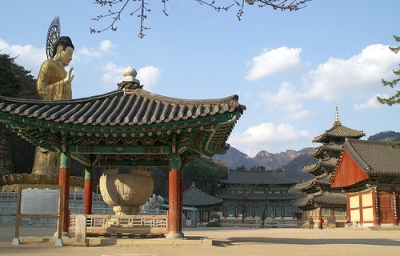 After several more hours of huffing, puffing, panting and ranting at Korean masochism, we reached a clearing at the top of a ridge. The sun took us in the eyes. When they had cleared, we beheld Beopjusa, a small Buddhist temple clinging to the side of the mountain. Just below it was Jangteomok Shelter. A huge crowd of hikers had gathered there, clad in brightly-hued synthetics, loitering about the picnic area below the temple entrance. Jeff and I selected a sizable rock some distance away from their staring eyes and had lunch.
After several more hours of huffing, puffing, panting and ranting at Korean masochism, we reached a clearing at the top of a ridge. The sun took us in the eyes. When they had cleared, we beheld Beopjusa, a small Buddhist temple clinging to the side of the mountain. Just below it was Jangteomok Shelter. A huge crowd of hikers had gathered there, clad in brightly-hued synthetics, loitering about the picnic area below the temple entrance. Jeff and I selected a sizable rock some distance away from their staring eyes and had lunch.
It was 4:30 p.m. Two and half miles down, one to go. The sun was getting steadily lower. It would soon pass behind the mountain peaks to the west and we’d lose the light. Nonetheless, we foolishly decided to press on.
Minutes later we stopped at a scenic overlook, a vast, recumbent table of rock jutting from the mountainside, commanding a supreme view of the valley below. Beyond the valley, scattered among the foothills, were white and red specks: the rooftops of Jungsan-ri, where we’d come. The blue skies to the southeast were tinged with gold from the sunset behind us.
I reached for my camera bag to take a picture.
I promptly discovered that my $300 Fujifilm camera had seemingly disappeared.
The carrying case hung innocently from my backpack, its top flap hanging loose, the broken zipper grinning incompetently at me.
Leaving Jeff at the overlook with the backpacks, I dashed back down the trail, hunting right and left. A helicopter departing from nearby delayed me. A red-clad man with gloves stood on the trail and held up a stern hand, in the manner of a traffic cop, until the chopper was safely away. I resumed my frantic search near the rock where Jeff and I had had lunch; I even inquired of the crowd (in Korean) if they had seen a lost camera. I got no reply.
Despondent and dejected, I returned slowly to the overlook. My endurance was fading along with the light. The sun was about to set. The sky was purpling. Hundreds of feet below the woods were tinged with fire and shadow. My head pounded. My heart ached. My legs throbbed — rubberized by thousands of stairs. Abandoning pretense, I flopped down next to Jeff, and both of us sat and looked silently out at the divine panorama.
Weary, sweaty, aching and heartsick, Jeff and I were forced to descend every last blasted stone of the thousands we’d traversed on the way up. We met all the same boulders, rocks and ridges, but now with the prospect of darkness closing in. It was agony. Soon, my leg muscles felt as though they were ripping loose from their moorings. My arms stung from lifting my tottering torso over endless obstacles. The blood blasted through my brain.
We also felt the keen sting of defeat. Every rock on the trail seemed to be tittering at our pathetic attempt to summit Jirisan.
To cheer ourselves up, the two of us began, deliriously, to play around with the word “gorp.” We made up puns and song titles, nonsense words and catch phrases: gorptastic, gorptacular, gorpin’ on up, gorpin’ it real, gorpified, and other ridiculous doggerel. It worked. Our spirits gradually rose as our elevation declined.
After two long hours, we stumbled out of the dusky woods at the trailhead, just as the last light vanished. Unable to stomach the thought of waiting for the bus, we caught a cab back to Jinju and a direct bus home.
For a week after I couldn’t go down a staircase unaided; I had to clutch the handrail and do most of the work with my upper body. My quads had gone on vacation and lactic acid was house-sitting.
Jirisan had defeated us — aided considerably by our lack of forethought. It was foolish of us to try to lug 30-pound packs up the greatest natural barrier in the country. The rough but simple beauty of the Sobaek Mountains, however, had awed us. Despite its heavy physical taxation, Jirisan is one of the most beautiful and popular national parks in Korea, patronized year-round by middle-aged Koreans with legs and lungs like mountain goats. Should you be in the vicinity of Gyeongsangnam Province and feel like giving Jirisan a try, rest assured, there are a multitude of less strenuous hikes than ours.
Just go prepared, and don’t over-gorp it.

Andrew Post is a freelance writer, pilot and bartender living somewhere in the California desert, and has lived in Tennessee, Ohio, North Dakota, Wyoming, and Washington, D.C. He has completed his first novel, a work of allegorical science fiction, and is currently working on the second.
Andrew will be taking a two-week hiatus from his novel-writing, high-flying lifestyle to visit Newcastle, Northumbria, England in June 2010. His travels throughout England, Ireland and Northeastern England will be covered in TheExpeditioner.com. He is also laying plans for a Fitzroy Maclean-style exploration of Uzbekistan; a one-year sojourn in Australia; an English-teaching contract in Japan; an overland trek from South Africa to New Zealand; and a voyage around the world as a volunteer deckhand on the HMS Bounty.
The post Almost Making It To The Top Of South Korea’s Jirisan appeared first on The Expeditioner Travel Site.
]]>The post Manners And Taboos: Advice For Watching Yourself Abroad appeared first on The Expeditioner Travel Site.
]]>
We all know different cultures have their specific intricacies, and it takes a little research to become aware of them when traveling. Even I remember a friend of mine in Korea, very politely saying, “Jon, ah . . . that is, maybe, a little bit rude.” After a thousand apologies and deep bows, I was instructed on the specifics of the gesture I was using (and it’s not the one you’re thinking).
Conde Naste and MSNBC dug up some of these touchy topics, and even rank ordered them by their offensiveness — how nice. Offering many specifics on places like Egypt, Jordan, Israel, Canada, and even America, they give one overarching and valuable piece of advice we all should keep in mind when interacting with, really, anyone: “Entering with an open mind and a do-no-harm approach is essential, and in many cases a focus on the simple things (friends, food, family) can create an oasis of peaceful coexistence.”
As for that mannerism I left you hanging with, the western “come here” motion with your hand is a palm up, flap of the fingers towards you — maybe a little bit rude in Korea. There, make sure you conduct that same motion with your palm down. Don’t say I never helped.
The post Manners And Taboos: Advice For Watching Yourself Abroad appeared first on The Expeditioner Travel Site.
]]>The post The DMZ: Travel To The Most Dangerous Place On Earth appeared first on The Expeditioner Travel Site.
]]>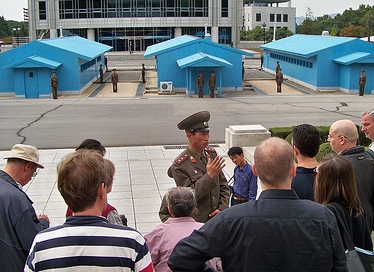
A trip to the DMZ only heightens the wish that one day, unification for the Koreans will no longer be a dream.
By Jon Wick
3/29/09
2:42 p.m. Dora Observatory, DMZ
Razor wire surrounded us as soon as we reached the northern border of Seoul. Manned watchtowers lined the rivers and even tanks cloaked in camouflage stood at the ready. The proximity of this otherworldly situation to the cultural and business center of the country was staggering. Our vulnerability was quickly becoming apparent.
Three weeks prior to this, I found myself searching for destinations to pass my time in Korea. I dusted off the idea of visiting the Demilitarized Zone (better known as the DMZ) from the recesses of my mind and decided to see if it was even possible. A simple internet search, a few clicks, and I had the intriguing world of the DMZ at my fingertips.
The only way to get there is through a guided tour, and without actually going into North Korea, there are far more options and itineraries available than I had ever imagined. You have a choice of half-, whole-, or two-day overnight trips to different locales along the world’s most heavily fortified border. I ended up selecting an adventure travel company, paying roughly $35 USD for the daylong option. An hour north of Seoul we were to visit an infiltration tunnel that could get Northern troops within a hour of Seoul, the special “Freedom Bridge,” and an observatory with a panorama of the DMZ and North Korea. Despite it being labeled as one of Korea’s most popular tours, it was no problem reserving a seat. My expectations of seeing a country the world sees as part of an “Axis of Evil” were at Guinness Book proportions.
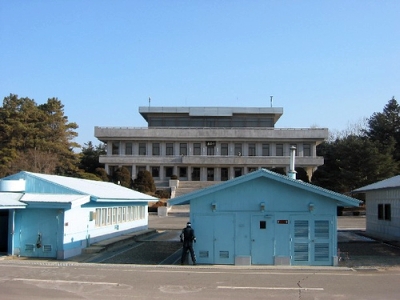 The bright sunshine made me squint as I took the final step off the tour bus. The two small United Nations and Republic of Korea army signs stood blindingly bright against the dank camouflage design of the modest building. The small rise of the pavement obstructed my view, only building my inner anticipation. Today, from the relative safety of the southern version of the DMZ, I was going to see what all those rumors of oppression and control looked like. I would lay my eyes on the most mysterious, threatening, and veiled country on the planet: North Korea.
The bright sunshine made me squint as I took the final step off the tour bus. The two small United Nations and Republic of Korea army signs stood blindingly bright against the dank camouflage design of the modest building. The small rise of the pavement obstructed my view, only building my inner anticipation. Today, from the relative safety of the southern version of the DMZ, I was going to see what all those rumors of oppression and control looked like. I would lay my eyes on the most mysterious, threatening, and veiled country on the planet: North Korea.
As we approached the platform, another reminder of strict picture-taking regulations was yelled from a fully armed Korean soldier; the tension was palpable. Each step brought a new and different vision of what may greet my eyes. Will we see the Northerners chained, wearing tattered clothing, working the rice fields to exhaustion? Would it be nothing more than an undeveloped moonscape just on the other side of the fence? Would I have the red dot of a North Korean laser scope on me at any point?
I stepped foot on the observation platform where the view yawned in all directions. Mountains framed a small distant city. The barbed wire meandered along the topography perpendicular to us. There was no moonscape and no apparent forced labor camps, just a continuation of rolling hills with the barren foliage of early spring — a striking continuation of Korea.
3/29/09
1:15 p.m. Third Infiltration Tunnel Theater
The camera slides gracefully over a lush mountaintop meadow. Pristine distant ridges are interrupted by a Korean child lifting a flower to the heavens. A voice finishes its soliloquy. “The DMZ will be a lasting memory of the unification of the Koreans for generations to come.” The lasting memory for those inside the theater is a unification of different sorts.
Our previous stop took us to what is known as the “Freedom Bridge,” the actual bridge used by northern refugees and POW’s returning south after the Korean War. Pictures of loved ones and family members, personal notes to them, and tattered flags lined the chain-link fence and drifted in the breezes skirting the rows of barbed wire. The memorial was a grave reminder of the rift, not only between countries, but between their people. It is with this emotion fresh in our minds, that we entered the theater.
The unification witnessed in the movie was not of the two Koreas, it was that of distant family members meeting after nearly 50 years of forced separation. The screen filled with images of men weeping in each other’s arms, mobbing one another after realizing their relation. In 2000, the North agreed to a temporary loosening of border regulations allowing such encounters. This policy has since been ended.
A lady to my right leaned towards me, eyes fixed on the screen. “Can you believe that this is true?”
“No,” I answered truthfully. “I can’t even begin to fathom what those people were going through.”
Emotion lingered thick over the audience. North, South, it didn’t matter . . . they were Korean.
4/03/09
4:26 p.m., from an e-mail issued by the U.S. embassy
The U.S. Embassy in Seoul is transmitting the following information through the Embassy’s warden system as a public service to all U.S. citizens in the Republic of Korea. Please disseminate this message to U.S. citizens in your organizations or to other Americans you know.
North Korea has announced that it will attempt a rocket launch between 11:00 a.m. and 4:00 p.m. on one of the days between April 4 – 8, 2009, from a site in northeast North Korea. This possible event has received much media attention. At this time, the U.S. Embassy in Seoul sees no potential danger to American citizens in South Korea as a result of the possible launch and does not believe that any special actions are warranted by American citizens other than to pay close attention to local news reports during this time period.
4/5/09
9:32 a.m. Seoul
With proof of the staunch ideologies, again, coming to a boil on a global scale, it seems bringing the two Koreas together is further out of reach than ever before. It was only after an e-mail from the U.S. embassy, with the reality of a North Korean missile launch dawning on me, that I stopped to reflect on what the DMZ and the separation of Korea truly means.
Leaving the DMZ along the same watchtower-dotted roads we came on, there was a much different energy felt inside the bus. At that time, there were only rumors of an impending missile launch that were seemingly overshadowed. There was a thick sense of collective heartbreak for the Korean families considered by those creating this situation as mere collateral damage. They are the ones heroically fighting a daily battle.
One can only hope that soon, the fences and barbed wire, along with the oppression and control, will come down and the continuation of the Korean peninsula, as witnessed from the Dora Observatory, can be a continuation of Korea and its people.
This tour is considered Korea’s most popular for a good reason: it leaves an unforgettable impression on those that reserve a seat. The fascinating, and often terrifying strip of land labeled DMZ, doesn’t just provide the taste of undeniable tension, it makes one feel the unbelievable emotion of family. The yearning for unification creates a hope that good will conquer in the end, and allow the Korean people to one day live harmoniously again.

The post The DMZ: Travel To The Most Dangerous Place On Earth appeared first on The Expeditioner Travel Site.
]]>